The Great Warehouse
“Site-specific performance exists within a plethora of phenomena, all competing for attention, all potentially meaningful: A concatenation of that at site and that brought to the site.” (Pearson, 2010, p.1).
The Great Central Library Warehouse (fig. 1): A site full of history, stimulating areas of exploration, and evidence of progression. In my past two years at the University of Lincoln I have spent more hours in the library that I can count, and never have I looked at the building the way I saw it over the past few months. The intense exploration of the library has provided me with an entirely new perspective of the building I have taken for granted for two years as “a place I go to do work”. All of these elements aided the composition of Ashley and I’s final performance, an interactive, artistic human ‘machine’ in the library’s Free Room. We performed our physical movement piece between the hours of 8am and 3:30pm on the 4th of May 2016. The durational aspect of our piece represented the hard labour machines and students go through when working. The exhibition was open for all to come and view, however we did create an online event inviting the people we know to come along.
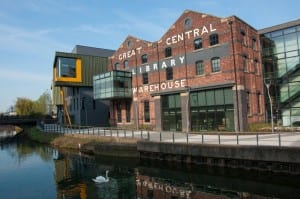
The first course of action was to discover as much about the history of the library as possible through research and our self conducted exploration. Then upon deciding our final performance would be a movement based piece we played around with contact improvisation, connecting with the space and watching videos on other site specific movement performers such as DV8 and Frantic Assembly for ideas and inspiration.
The Process
Zibby Garnett- From the very beginning of the process, both Ashley and I were drawn to the Zibby Garnett library. This little one room library within a library was jam packed with old books only available for reference and lots of gold mines of hidden, intriguing material. The room is a little haven away from the rest of the library, a sublime paradise. We sat in that room in silence for hours, soaking up it’s presence. Every time I went in the room I found something new, from old photos (fig. 2), to folders full of dadaist programs and leaflets in a range on languages. Vintage magazines to tattered copies of children’s books.
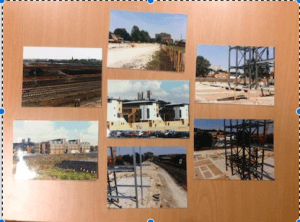
The most important find was the Ruston Hornsby schematics. On a day when we started to feel like we could explore the space no more, I stumbled upon the log-in information for one of the computers. From there I went into the photos and found folders full of scans of schematics for machinery (fig. 3 and 4) used in the library. We went on to use these in our final piece. These schematics were so important as they were central to the idea of our performance, they were displayed in the performance space and were what we based our final creation and movement from.
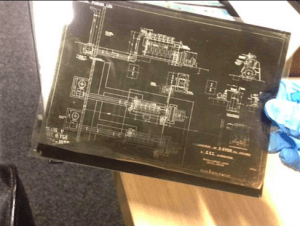
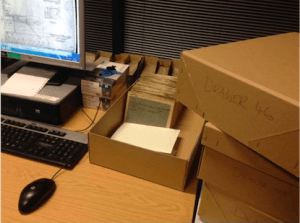
Marina Abramovic- Abramovic was a main source of inspiration for our piece. Her ideas on what performance and art should be were something I kept referring back to throughout the entire process. She once said “The hardest thing to do is something that is close to nothing because it is demanding all of you.” (abramović, 2016) (fig. 5 and 6), which only reinforced the idea that our piece should be simple. The whole concept of our piece was simplistic, yet the durational and physical aspects, and even the parts where we were doing ‘nothing’, were exhausting and only worked with intense concentration.
Marina Abramovic – The Artist is Present trailer (fig. 5)
“It was a big base of my performance art … the idea of here and now … not something that’s happening in the past or the future. It’s always happening. It’s always now…. Only what matters is the present.” (Abramovic, 2015). This is what I kept in my mind the whole time. “The idea of the here and now”. Ashley and I working together was about engaging with each other (fig. 7), feeling what the other was about to do, not a routine pre-meditated like our original idea was. Both of us were used to working with choreographed movement and we wanted to break away from this and completely be in the present with each other.
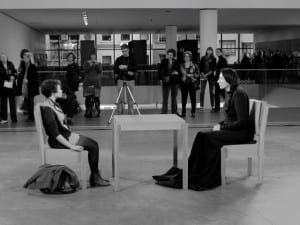
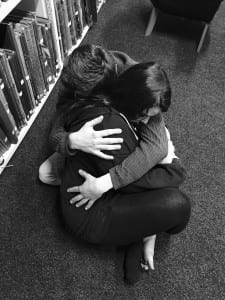
DreamThinkSpeak- One of the first companies I looked at was DreamThinkSpeak. This is where I first head of ‘transforming’ a site, and taking from a site to create an immersive performance. In this video artistic director Tristan Sharps talks about “fusing different media” (Sharps, 2016), something we took on board for our performance, using a sound scape, physical movement and a technical screen representing controls for the machine. I only wish we had of pushed the use of media further in our piece. He also talks about how the ending of The Rest is Silence (fig. 8) will differ slightly depending on where it is performed. This transfers itself to our performance in that out piece may differ depending on who it is performed to, and how they interact with us.
DreamThinkSpeak – The Rest Is Silence (fig. 8)
Frantic Assembly- Frantic assembly use what they refer to as “building blocks” (See fig. 9) for devising a movement piece. The video below explains two of the main techniques we used when creating our performance: Round-By-Through and Hymns Hands (Fig. 9 and 10). It’s interesting to see how something so simple can start telling a story, start having meaning when the performers are engaged with one another. We took the idea of shifting focus from Frantic Assembly, see how when they shift their visual attention to their hands, the focus of the observer shifts too. We used this in our piece, drawing attention to the book and then to each other creating an energy in the room.
Frantic Assembly Masterclass: Building Blocks for Devising (fig. 9)
Exploring Round-By-Through and Hymns Hands (fig. 10)
https://www.youtube.com/watch?v=cSHwB1vPiOQ
DV8- For me, DV8 is by far the most inspirational and mesmerising pieces of work I looked at. In their piece Enter Achilles (fig. 11) they display a hypnotising routine set within a pub demonstrating and exploring the stereotypical views on masculinity. The performers use movement to establish a relationship with the space around them, each other and particularity in this piece the relationship between the male performer and the pint glass. We wanted to take the connection they have with their pint glass and cigarette and transfer that into our own work, the connection between us, our books and each other. The DV8 performers move together seemingly effortlessly with fluidity and focus. I hoped to get as close to this style of performance for our final piece.
Enter Achilles – DV8 Physical Theatre (fig. 11)
https://www.youtube.com/watch?v=5PFR2OXf9iQ&feature=youtu.be
The Bombshell
After planning our performance around the Zibby Garnett Library, we received the devastating news that we would not be able to use the room for our performance (fig. 12).

This meant that we had to change our space last minute, which in turn changed our performance slightly – the lay out of the space, a change in the tables available for us to use. We looked at using The Worth Room however decided the room was too small, and the tables were an inappropriate size for our needs. We finally decided upon The Free Room due to it’s size, flexibility for booking out for a long amount go time and being in clear view to passers by.
The Final Performance

When you walked into the room you see (fig. 13) a table with two laptops, one with the video (fig. 14) and the other with an on/off button. In the center of the room there are two tables sectioned in by yellow and black tape. Stacks of books on the floor by the windows adorned with schematics, and sign with instructions: Load the machine with books, press “on”. Once these instructions are followed the ‘machine’ starts, slowly we “warm up” from a resting position to standing. Then we move a book at a time from one table to the other using each other to hold to book in place, using our vision to draw all focus on to the book. The book gets deposited on the other table to resemble the schematics, cogs, machinery. The focus changes onto Ashley and I, we move together using each others body, not moving without taking the other with you, back to the “loading station” ready to start again until the machine is shut down with the off button, or until it automatically shuts down after 25 minuets.
The video (fig. 14) –
https://www.youtube.com/watch?v=dIEbyC6N24M
Our final performance had strengths in the following areas – unity, informative and relevance. Ashley and I, though I struggled at the bringing of this project, became able to work closely together with ease. We became a unit of one for our final performance. This was a necessary element for our piece due to us representing a machine, mechanical parts do not work if another piece is missing or broken, the same thing applies for performers in a piece such as ours. The video containing information on the history of the library available for viewing during our performance was highly informative. It gave a detailed description of the history of the building, what the building once was and where we can see evidence of this in our current library. The video also gave examples of connections between the history and our other influences, and our performance. Our piece was very relevant to the site, focusing on the history and incorporating evidence we found through spending ample time in the library, for example the schematics I found (fig. 15, 16 and 17).
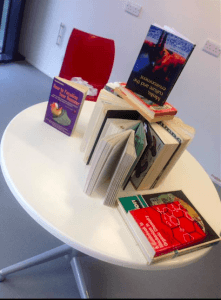
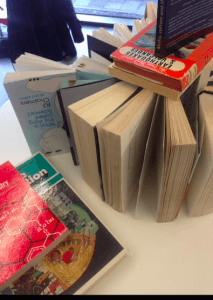
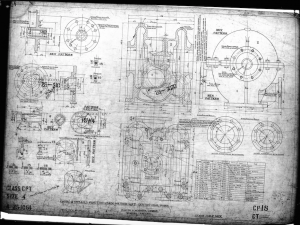
There are some things noticed only in reflection of the final performance. The space it’s self could have been transformed much better, the schematics could have been more accessible and had we had more time there could have been more interactive stations within the room. These alterations may have boosted our audience numbers. I would estimate only around 15 people turned up during the entire 8 hours. The performance should have been more widely advertised and better sign posted for passers by. The audience members that did take part stayed approximately between 5 and 20 minuets, though it was sensed some audience members got bored which legitimises my point about having more interactive stations.
During the performance I heard a few audience members discuss that they did not know some of the information provided in the video. The video clearly created an impact and sparked interest in the library’s former state which was the overall aim for our performance.
What is Art?
Art is seen and created differently by everyone, based on perspective-
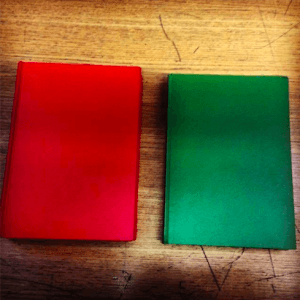
And sometimes by breaking the rules a little bit.
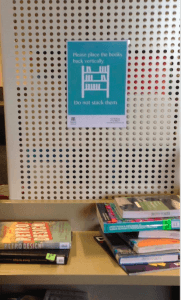
Works Cited
Dreamthinkspeak- The Rest Is Silence”. YouTube. N.p., 2016. Web. 13 May 2016.
Pearson, Mike. Site Specific Performance. Houndmills, Basingstoke, Hampshire: Palgrave Macmillan, 2010. Print.
Marina Abramović The Artist Is Present Trailer HBO”. YouTube. N.p., 2016. Web. 13 May 2016.
Groves, Nancy. “Marina Abramović: ‘The Planet Is Dying. We Have To Be Warriors'”. the Guardian. N.p., 2015. Web. 13 May 2016.
Frantic Assembly Masterclass: Building Blocks For Devising”. YouTube. N.p., 2016. Web. 13 May 2016.
Enter Achilles – DV8 Physical Theatre”. YouTube. N.p., 2016. Web. 13 May 2016.